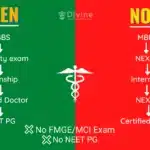Embarking on a medical career in the USA is a significant endeavor for Indian students. The journey from MBBS to MD involves a comprehensive understanding of the educational pathway, strategic academic planning, and careful financial management. This article provides insights into the key aspects of pursuing a medical education in the USA, including eligibility criteria, program comparisons, application processes, and career opportunities post-graduation. With the right approach, Indian students can navigate the complexities of the US medical education system and achieve their aspirations of becoming globally recognized physicians.
Key Takeaways
- Indian students must complete pre-medical coursework and pass standardized tests like the MCAT to be eligible for MD programs in the USA.
- Selecting the right medical school involves considering factors such as academic fit, career goals, and financial implications.
- Financial planning is crucial, as the cost of medical education in the USA is high, but scholarships and funding options are available.
- Cultural and educational adjustments are part of the journey, and building a professional network is essential for success.
- Achieving residency in the USA is competitive, requiring strong Letters of Recommendation and a well-rounded profile.
Understanding the MBBS to MD Pathway in the USA

Eligibility Criteria and Academic Requirements
For Indian students aspiring to study medicine in the USA, understanding the eligibility criteria and academic requirements is the first step towards achieving their dream. A strong foundation in science subjects is essential, as evidenced by high school performance, particularly in biology, chemistry, and physics. Additionally, proficiency in English is a prerequisite, often validated by standardized tests such as the TOEFL or IELTS.
The academic journey begins with a bachelor’s degree, preferably in a pre-medical field, followed by the Medical College Admission Test (MCAT). The MCAT assesses problem-solving, critical thinking, and knowledge of natural, behavioral, and social science concepts and principles prerequisite to the study of medicine.
The transition from MBBS to MD involves not only academic preparation but also adapting to a new educational and cultural environment. Proactive research and networking with professionals who have successfully made this transition can provide invaluable insights.
Here is a list of standardized tests that Indian students may need to prepare for:
- MCAT: Medical College Admission Test
- USMLE: United States Medical Licensing Examination
- TOEFL: Test of English as a Foreign Language
- IELTS: International English Language Testing System
Each of these tests has specific eligibility criteria, registration processes, and scoring systems. It is crucial for students to familiarize themselves with these details well in advance to plan their study schedule accordingly.
Pre-medical Coursework and Standardized Tests
The journey to a medical career in the USA for Indian students necessitates a solid foundation in pre-medical coursework and a strong performance in standardized tests. Completing the necessary pre-medical courses is a critical step, which typically includes subjects like biology, chemistry, and physics. These courses lay the groundwork for the Medical College Admission Test (MCAT), a pivotal component of the medical school application process.
In addition to coursework, students must prepare for and excel in the MCAT to demonstrate their readiness for medical education. The MCAT assesses knowledge in various areas, including biological and physical sciences, verbal reasoning, and writing skills. Here’s a brief overview of the MCAT components:
- Biological Sciences
- Physical Sciences
- Verbal Reasoning
- Writing Sample
The MCAT is not just a test of knowledge, but also a measure of critical thinking and problem-solving abilities, skills that are essential for success in medical school and beyond.
It’s important to note that some students may face challenges due to the differences in educational systems. For instance, a bachelor’s degree obtained in India may not be directly accepted for medical school admission in the US. Therefore, Indian students must ensure that their undergraduate education aligns with the requirements of US medical schools. Strategic planning and early preparation are essential to navigate these academic prerequisites and to secure a place in a competitive medical program.
Clinical Experience and USMLE Steps
Gaining clinical experience in the United States is a pivotal component of the journey for Indian students transitioning from MBBS to MD. It provides an opportunity to understand the healthcare system and to demonstrate familiarity with its workflows and standards of care. Securing U.S. clinical rotations can significantly boost an application’s competitiveness for residency positions. Residency programs often favor applicants with U.S. clinical exposure, as it shows an ability to adapt to the U.S. medical culture and technology.
The United States Medical Licensing Examination (USMLE) is a series of exams that are essential for medical licensure in the USA. Indian students must pass all three steps of the USMLE, which comes with both time and financial considerations. The USMLE Step 1, typically taken after the second year of medical school, assesses foundational medical knowledge. Step 2 evaluates clinical knowledge and skills, and Step 3, which is often integrated into the residency program, focuses on the ability to practice medicine independently.
Early and consistent preparation for the USMLE, integrated with medical school curricula, is essential for success. This approach not only prepares students for the exams but also for their future roles as independent practitioners.
Here is a simplified timeline for USMLE preparation:
- Year 2: Take USMLE Step 1
- Year 3: Clinical rotations and preparation for USMLE Step 2
- Year 4: Take USMLE Step 2
- Residency: Take USMLE Step 3 after the first year
Medical schools in the USA often provide structured support for USMLE preparation, including access to resources, practice exams, and guidance from faculty experienced in the USMLE process. This comprehensive support system is designed to ensure that students are well-equipped to meet the high standards set by the medical profession in the United States.
Choosing the Right Medical School

Factors to Consider When Selecting a Medical School
Selecting the right medical school is a pivotal decision in the journey of an Indian student aspiring to study medicine in the USA. The quality of education, types of programs offered, and the institution’s reputation are just the beginning of a long list of considerations. One must delve deeper into the specifics of each school to ensure the best fit for their medical career aspirations.
The curriculum and faculty of a medical school are crucial elements that can significantly impact your education. Schools that follow a US-style curriculum are often preferred, as they align closely with the requirements of USMLE and residency programs. Additionally, the faculty’s expertise and their approach to teaching and mentorship can greatly influence your learning experience and professional growth.
- Location and campus life
- Research opportunities and facilities
- Support services for international students
- Alumni network and residency placement rates
When evaluating medical schools, it’s important to consider how each factor aligns with your personal and professional goals. A school that offers a supportive environment, ample research opportunities, and a strong network can be instrumental in your success.
Ultimately, the decision should be based on a comprehensive assessment of how well the school’s offerings match your educational needs and long-term career objectives. It’s a balance of academic rigor, practical training, and personal development that will pave the way for a fulfilling medical career.
Understanding the Application Process
The application process for medical schools in the USA is a meticulous journey that requires careful planning and attention to detail. Navigating this process successfully is pivotal for Indian students aspiring to study medicine in the USA. The first step is to ensure that all eligibility criteria are met, including academic prerequisites and standardized tests like the MCAT.
Eligibility Criteria: Indian students must have completed their pre-medical coursework and obtained the necessary scores on standardized tests. Additionally, clinical experience is highly regarded and can be a differentiating factor in the application.
- Compile all necessary documentation, including transcripts, test scores, and letters of recommendation.
- Complete the primary application, often through the American Medical College Application Service (AMCAS).
- Prepare for and attend medical school interviews, showcasing your motivation and suitability for the profession.
The application process is not just a formality but a reflection of your dedication and readiness for the rigorous medical education that awaits.
Finally, it is essential to understand the timelines and adhere to the deadlines set by each medical school. A well-crafted application that highlights your strengths and commitment to medicine can set you apart in a competitive field.
Networking and Research
Networking and research are pivotal in choosing the right medical school in the USA. Engaging with current students and alumni can provide insights into the school’s culture and educational approach. Participating in online forums and attending medical conferences can also be beneficial. Here are some steps to enhance your networking and research efforts:
- Join medicine community discussions to learn from peers and professionals.
- Attend advanced medicine summer schools and conferences for exposure.
- Utilize online platforms like The Student Room for resources and connections.
Proactive networking and thorough research are indispensable for making an informed decision about your medical education.
It’s also crucial to understand the application process for each school. For instance, some schools may value clinical experience highly, while others focus on academic achievements. By researching and networking, you can tailor your application to align with the school’s preferences, thereby increasing your chances of acceptance.
Financial Planning for Medical Education

Estimating the Costs of Studying Medicine in the USA
Understanding the financial implications of studying medicine in the USA is crucial for Indian students. The journey begins with tuition fees, which can vary significantly from one institution to another. For instance, Harvard University stands among the institutions with the highest medical study costs in the USA, with tuition fees reaching USD 71,032 per year. On the other hand, more affordable options exist, such as the University of New Mexico, with annual tuition fees of USD 15,788.
In addition to tuition, living expenses play a substantial role in the overall cost. Accommodation, meals, transportation, and utilities are key components of this. For example, monthly housing rent can average around USD 1,769.02, while a monthly transportation pass may cost USD 72. Below is a table summarizing the estimated monthly living expenses in the USA (Note: 1 USD = Rs 83.43):
| Particular | Estimated Cost (USD) | Cost in Indian Rupees (Rs) |
|---|---|---|
| Housing (Rent) | 1,769.02 | 147,585.71 |
| Transportation (Monthly Pass) | 72 | 6,006.81 |
| Meal | 20 | 1,668.56 |
| Utilities (Monthly) | 205.70 | 17,161.13 |
The cost of living is a major factor, and students should consider both on-campus and off-campus living options to find the most economical solution.
It is also important to account for additional costs, such as medical checkups and student visa fees, which can add up to INR 14,000 to INR 21,000. By carefully estimating these expenses, students can better prepare for their financial needs while studying medicine in the USA.
Exploring Scholarship and Funding Options
Securing scholarships and funding is a pivotal step for Indian students aiming to study medicine in the USA. Scholarships can significantly reduce the financial burden of tuition and living expenses. It’s important to start researching early, as many scholarships have strict deadlines and require detailed applications.
Types of Financial Aid Available:
- Need-based scholarships
- Merit-based scholarships
- College-specific scholarships
- Country-specific scholarships
Financial planning is not just about covering costs, but also about exploring opportunities for scholarships and financial aid to ease the burden. By thoroughly estimating the costs and exploring financial aid options, students can take a step closer to realizing their medical education goals in the USA.
Financial constraints are real, but so are scholarships. Many students miss out on available financial aid because they don’t look for it or assume they won’t qualify.
To streamline your search for financial aid, consider the following steps:
- Research scholarships offered by universities, governments, and private organizations.
- Prepare a compelling application, highlighting your academic achievements and extracurricular involvement.
- Provide proof of financial capability, as some institutions require a bank statement showing sufficient funds.
Proactive engagement with overseas medical education consultants can provide valuable assistance in financial planning and understanding the nuances of scholarship applications. While the costs of studying medicine abroad can be high, the investment in your future career prospects and global exposure is invaluable. Explore all avenues of financial aid to make your medical education journey more accessible.
Budgeting and Financial Management Strategies
Effective financial management is a cornerstone of a successful medical education journey in the USA. Developing a comprehensive budget that accounts for tuition, living expenses, and additional costs such as USMLE preparation is crucial. Students should consider various strategies to manage their finances, including scholarships, part-time jobs, and careful tracking of expenses.
Scholarships play a pivotal role in easing the financial load, and students are encouraged to apply for as many as they qualify for. Additionally, part-time employment can supplement income and provide practical experience. It’s important to regularly review and adjust the budget to reflect any changes in circumstances or spending.
By proactively managing finances and exploring all available resources, students can mitigate the financial challenges of studying medicine in the USA.
Here are some practical steps to consider for budgeting and financial management:
- Identify all potential sources of income, including scholarships, grants, and part-time work.
- List all expected expenses, categorizing them into tuition, books, housing, food, and miscellaneous items.
- Create a monthly budget and track actual spending to identify areas for cost savings.
- Review and adjust the budget periodically to stay on track with financial goals.
Navigating Cultural and Educational Adjustments

Adapting to the US Educational System
For Indian students accustomed to the MBBS curriculum, adapting to the MD program in the USA involves understanding a new educational structure. The shift from a theoretical focus to a more clinical and practical approach is significant. It’s essential to embrace the interactive learning style prevalent in U.S. medical schools, which often includes case-based discussions and problem-solving sessions.
Key aspects of the U.S. educational system include:
- Emphasis on self-directed learning and critical thinking.
- Regular assessments through quizzes, exams, and practical evaluations.
- Participation in research projects and extracurricular activities.
- Clinical rotations in various medical specialties.
Adapting to this system requires flexibility and a willingness to actively engage in the learning process. It’s not just about acquiring knowledge, but also about developing the skills to apply it effectively in a clinical setting.
Students should also be prepared for the rigorous assessment methods used in U.S. medical schools. These evaluations are designed to ensure that students are well-prepared for their future roles as physicians. Networking with peers and faculty can provide support and guidance through this transition.
Cultural Integration and Support Systems
For Indian students, the transition to medical education in the USA is not just an academic shift but also a cultural journey. Adapting to a new cultural environment is as crucial as mastering the curriculum. Support systems, such as student organizations and cultural societies, play a vital role in easing this transition. They provide a platform for networking, sharing experiences, and fostering a sense of community among international students.
- Engage with cultural societies and student organizations
- Participate in international student events and activities
- Seek mentorship from seniors or faculty familiar with the transition
Integrating into the US culture requires an open mind and a willingness to learn from diverse experiences. It’s about finding a balance between preserving one’s own cultural identity and embracing the new environment.
The study titled ‘[PDF] Social and Cultural Integration of International Students with American’ highlights the importance of a sense of belonging on an American college campus. It is essential for Indian students to actively seek out and utilize these support systems to ensure a smooth and enriching educational journey.
Building a Professional Network in the Medical Community
For Indian students pursuing an MD in the USA, building a professional network is a critical step towards integrating into the medical community and enhancing career prospects. Networking can open doors to research opportunities, mentorship, and valuable clinical experiences. Here are some practical ways to expand your professional circle:
- Attend medical conferences and seminars to meet peers and industry leaders.
- Join professional medical associations to connect with fellow medical professionals.
- Engage in online forums and discussions related to your field of interest.
- Volunteer or participate in clinical rotations to establish relationships with practicing physicians.
Networking is not just about collecting contacts; it’s about cultivating meaningful relationships that can support your career development.
Adapting to the US educational system and cultural nuances requires proactive effort. Indian students must navigate through cultural, educational differences such as language barriers, teaching styles, and visa complexities. It is essential to seek out communities and resources that can aid in this transition, ensuring a smoother academic journey and integration into the medical community.
Achieving Residency and Beyond

Preparing for Residency Applications
For Indian MBBS graduates aiming for a medical career in the USA, preparing for residency applications is a critical step. The process is highly competitive, especially for International Medical Graduates (IMGs), with a strong preference for American medical school graduates. Securing a residency spot in specialties other than Internal Medicine and Family Medicine can be particularly challenging.
To enhance your chances of matching into a residency program, consider the following steps:
- Gain clinical experience in the US healthcare system.
- Prepare diligently for the USMLE Steps 1 and 2.
- Obtain strong Letters of Recommendation, preferably from US-based clinicians.
- Strategically plan your application to highlight your strengths and experiences.
The transition from MBBS to MD involves not only academic preparation but also adapting to a new educational and cultural environment. Proactive research and networking with professionals who have successfully made this transition can provide invaluable insights.
Remember, the pathway from an MBBS to an MD in the USA requires understanding the nuances of the US medical education system and the residency process. It is essential to build a well-rounded profile and strategically plan your journey to increase your chances of success.
Securing Strong Letters of Recommendation
Securing strong Letters of Recommendation (LORs) is a pivotal component of the residency application process for Indian students pursuing an MD in the USA. A well-crafted LOR can significantly enhance your application, showcasing your clinical competencies and professional demeanor to potential residency programs. To ensure you receive impactful recommendations, consider the following steps:
- Establish meaningful relationships with mentors and supervisors during clinical rotations.
- Demonstrate your medical knowledge, skills, and commitment to patient care.
- Request LORs well in advance of application deadlines to allow ample time for writing.
- Provide your recommenders with your CV, personal statement, and any other relevant materials to help them write a personalized and detailed LOR.
It’s essential to choose recommenders who are not only familiar with your work but also hold a reputable position in the medical community. Their endorsement can carry significant weight in the decision-making process.
Remember, a strong LOR reflects both your past performance and your potential as a future physician. It’s an investment in your professional future, so approach it with the seriousness it deserves.
Long-Term Career Prospects and Global Opportunities
The pursuit of an MD in the USA opens a plethora of long-term career prospects for Indian students, not just within the United States but also on a global scale. Securing a US MD degree equips graduates with a highly respected qualification that is recognized worldwide, offering a competitive edge in the international job market. The US medical education system’s emphasis on research and clinical experience makes its graduates sought after by healthcare institutions across the globe.
For those considering international practice, it’s essential to understand the licensing requirements of the desired country. Many Indian doctors have successfully transitioned to practice in countries like Canada, Singapore, New Zealand, and the UK, among others. Each country has its own set of examinations and criteria that foreign medical graduates must meet. For instance, to practice in the UK, doctors must pass the PLAB test, while the USMLE is necessary for the USA.
The global recognition of a US MD degree can significantly enhance your career mobility and open doors to diverse opportunities in healthcare.
In addition to clinical practice, MD graduates have the option to delve into research, teaching, or healthcare administration. The skills and knowledge acquired during their education enable them to contribute to medical science advancements and healthcare policy development. With strategic planning and a focus on continuous learning, the long-term career prospects for Indian students with a US MD are both promising and expansive.
Embarking on the journey to become a US-qualified doctor is now within your reach, without the hurdles of MCAT or NEET. Divine Education Abroad Consultancy offers a Fast-Track MD Pathway, ensuring a 97x higher success rate and a 100% admission guarantee. With affordable education options and personalized guidance, we pave the way for your medical career in the US/UK. Don’t let financial constraints or fear of the unknown hold you back. Take the first step towards your dream by visiting our website and discovering how we can help you achieve residency and beyond.
Conclusion
In conclusion, the journey to study medicine in the USA for Indian students is a challenging yet rewarding pathway that requires meticulous planning, dedication, and resilience. From understanding the eligibility criteria and navigating the complex admission process to securing financial aid and adapting to a new educational system, each step is crucial for success. The article has outlined the key aspects of pursuing an MBBS to MD transition, including strategic academic advantages, financial considerations, and the importance of clinical experience. Indian students must be proactive in their preparation, seek guidance from experts, and remain adaptable to the cultural and academic differences they will encounter. With a clear roadmap and a strategic approach, Indian students can achieve their dreams of becoming globally recognized physicians, making the investment of time, effort, and resources a worthwhile endeavor for a promising medical career.
Frequently Asked Questions
What are the eligibility criteria for Indian students to study medicine in the USA?
Indian students must have a strong science background, proficiency in English (TOEFL/IELTS scores may be required), and a minimum GPA. They also need to complete necessary pre-medical coursework and standardized tests like the MCAT.
Can Indian students with an MBBS degree pursue an MD in the USA?
Yes, Indian MBBS graduates can pursue an MD in the USA by clearing USMLE Steps 1 and 2, securing a residency match in the US, and gaining US clinical experience.
What financial planning should Indian students undertake for studying medicine in the USA?
Students should estimate the costs, explore scholarship and funding options, and develop budgeting and financial management strategies to manage the high tuition and living expenses.
What are the challenges Indian students face when applying for medical schools in the USA?
Challenges include high competition for limited seats, complex admission processes, financial burden, and navigating visa and immigration policies. Students also need to adapt to cultural and educational differences.
How can Indian students increase their chances of getting into a US medical school?
Indian students can enhance their chances by applying to multiple universities, staying organized with deadlines, seeking clinical experience, networking, and securing strong Letters of Recommendation.
What are the long-term career prospects for Indian students who complete an MD in the USA?
MD graduates have promising career opportunities with residency and specialization in the USA. The degree’s global recognition also opens doors to international practice, though returning to India requires passing the FMGE.














